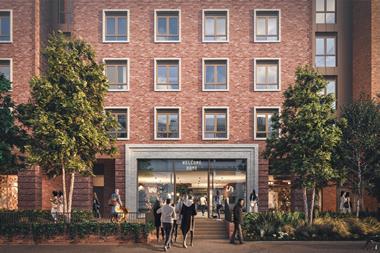Never one of the UK’s more glamorous retail destinations, Leicester is about to have its shopping offer transformed. Ben Cooper visits the city to find out what is so different about its scheme
Amid the flood of city centre trasformations coming up in the UK this year, Leicester has been keeping a low profile. With large-scale projects in Liverpool, Bristol and London the subject of much discussion, the Hammerson and Hermes scheme in the Midlands city has courted less attention. Its impact on Leicester, however, will be critical.
Highcross Leicester is a shopping centre of its time. As well as a substantial retail offering, it includes leisure, catering and residential aspects – a style of development that the centre of Leicester hasn’t seen before. Hammerson believes that the scheme will be a catalyst for change, bringing not only shoppers to the centre of Leicester, but city living as well. Evidence that it is already changing perceptions is in the significant number of retailers in the centre that are new to the city.
Highcross has two crucial elements. The scheme’s biggest asset is the priceless draw of John Lewis, which – as is invariably the case – has unlocked a whole new level of potential in the retailers it can attract. On the other hand, the project’s residential element is an area that might be causing a few sleepless nights given the clouds that are forming over the housing market and the fact that city living on this scale is a new concept for Leicester.
John Lewis retail development manager Samantha Rowntree says: “There’s a really nice holistic feel around the whole project. It was a great opportunity to both better our coverage in the East Midlands and be involved with a project with an excellent tenant mix. I’m very keen that we’re seen not just as being a part of Highcross, but the regeneration of Leicester as well.”
Hammerson and Hermes have embarked on an ambitious project in Highcross. By the time the centre opens on September 4, it will span more than 1 million sq ft (100,000 sq m) and have cost the development partnership£350 million. Architect Chapman Taylor – whose achievements include the Bullring in Birmingham, Bristol’s Cabot Circus and the Princesshay centre in Exeter – has been responsible for the masterplan that encompasses 409,000 sq ft (37,995 sq m) of retail space, 120 apartments, two public squares, 3,000 parking spaces and a 12-screen cinema.
Hammerson has also embarked on an extensive£25 million refurbishment of the Shires Centre – its existing asset in Leicester – which adjoins Highcross and will be amalgamated with it once it opens. Over the past two years, the developer has added energy-efficient lighting and limestone flooring, removed all artificial air conditioning, installed movement-reactor escalators and two glass lifts, added new entrances, doors and handrails and made all toilets accessible to disabled customers.
Inevitably, the existing centre has lost a few tenants to the new scheme. Most notably Next – which was founded in Leicester – will leave its 7,000 sq ft (650 sq m) unit at the Shires and upgrade to a 50,000 sq ft (4,645 sq m) two-level store at the new development. Voids left by the departure of Next and other retailers – including River Island – are in the process of being filled.
Sitting among some hefty competition, Leicester has, for a long time, been overshadowed as a retail centre. Nearby Nottingham’s vim and vibrancy has made it attractive to edgy fashion retailers historically and, with a culture of city living now well-established, it is the destination that Leicester aspires to be. Elsewhere, Westfield Derby will be approaching its first birthday when Highcross opens and the Bullring in Birmingham has firmly found its feet.
With such a strong line-up of successful centres there, a newcomer needs to do something different if it’s going to draw in shoppers from its own catchment, let alone make a real impact. However, Highcross does have several factors in its favour.
Compact and bijou
Nottingham, for example, doesn’t have a mixed-use scheme on the same scale as Highcross. While the retail offer there is impressive, it is scattered across the city centre. Leicester’s smaller city centre and more concentrated shopping offering, in addition to the fact that the new development is tagged on to the already established Shires centre, means that Highcross will offer a compact retail mix in the heart of an already dense shopping environment.
The two large shopping centres in Nottingham, Westfield’s Broadmarsh Centre and the Victoria Centre, are at opposite ends of an older generation of retail development. Highcross is part of the new wave of centres that have an abundance of wide, open spaces and natural light, with a genuine mixed-use offering. For retailers, which are getting pickier when it comes to the centres they occupy, Highcross is a modern destination that – until Westfield redevelops the Broadmarsh in Nottingham – might prove more inviting because of the variety of its offering.
And this, according to Hammerson director of retail leasing Sheila King, is long overdue. “If you looked at Leicester before, the environment wasn’t right for retail, but Highcross has been a catalyst. Leicester was in great need of mixed-use opportunities. It was lagging behind as a city, but that’s because it hadn’t had the investment,” she says.
In fact, the centre is approaching 85 per cent let and has brought a string of retailers into Leicester that almost certainly wouldn’t have considered the city before. Fashion brands G-Star, Lacoste, Henleys, Ghost, All Saints, Hugo Boss, Reiss and Zara are all new to Leicester. The presence of John Lewis has assuaged any doubts that retailers might have had about getting on board.
The 236,815 sq ft (22,000 sq m) John Lewis anchor store is an imposing feature of Highcross. Standing over three floors, it is the main point of entry from the 3,000-space car park and is decorated with a spectacular three-layer glass pattern taken from an original John Lewis hosiery collection from 1803.
“The real catalyst was bringing John Lewis to Leicester,” says Cushman & Wakefield partner Justin Taylor, who is letting agent on Highcross. “It gives you a very strong case to make when it comes to ongoing lettings.”
Highcross’s pivotal point might be in the success or failure of its residential element. For a number of reasons this presents challenges. With 120 apartments in the heart of the scheme, it is the first time that significant residential development has been undertaken in the heart of Leicester. It’s also the first time that Hammerson has made the decision to manage a residential project after completion.
It is a big step for the developer, but this isn’t to say that the demand isn’t there for city centre living, especially considering that 250,000 people work in the centre of Leicester. This part of the scheme is a venture that Hammerson is remaining flexible about to ensure that, whatever the next few years of turmoil bring, the overall scheme will prosper.
This doesn’t detract from the fact that Highcross is exactly what Leicester needs. Whether or not the city climbs to 10th place in the retail rankings as Hammerson and Hermes estimate that it will remains to be seen, but the development is a total regeneration of a retail centre that has, for years, failed to fulfil its potential. It may not be the most prominent of the developments that are being completed this year in the UK but, for Leicester and the Midlands, Highcross revitalise what has hitherto been a rejected centre.
Since we last visited
Land Securities has completed the first stage of a retail-led regeneration project in Corby and submitted plans for the second phase, which could begin as soon as 2010. The first phase, Willow Place covers 175,000 sq ft (16,260 sq m) and is anchored by TK Maxx, with a second anchor, Primark, due to open this summer. In March, the developer submitted plans for the second stage, Evolution Corby – a 330,000 sq ft (30,655 sq m) addition that would bring a further 30 retail units, including a 120,000 sq ft (11,150 sq m) anchor.
Vale Retail has embarked on a£30 million refurbishment of the Cornbow shopping centre at Halesowen, near Dudley in the West Midlands. The work will bring a new Asda to anchor the scheme – which includes Argos, Gamestation, Clarks, Peacocks and Bonmarch頢 a new car park, bus station and improvements to the surrounding road system. It will be completed in time for Christmas.
In Birmingham, The Mailbox’s developer, Birmingham Development Company, is building an extension to the centre. The Cube will cover 500,000 sq ft (46,450 sq m) and will include 30,000 sq ft (2,785 sq m) of retail and leisure space, as well as 135 flats and 111,500 sq ft (10,360 sq m) of office space. The work is scheduled for completion in 2010.
Multi Development has been given the green light for its£300 million redevelopment of a 775,000 sq ft (72,000 sq m) site in Wolverhampton. Work will begin this summer on the mixed-use scheme, Summer Row, which will be anchored by a 105,000 sq ft (9,755 sq m) Debenhams store and will include 85 other stores and 150 apartments.


























No comments yet